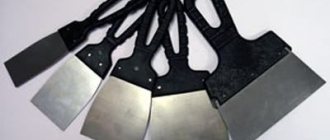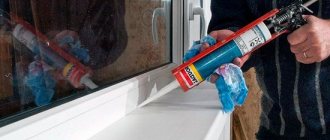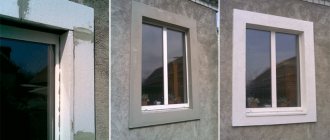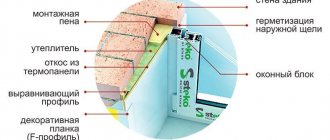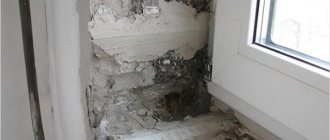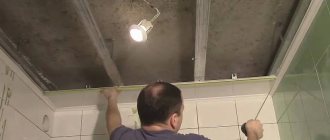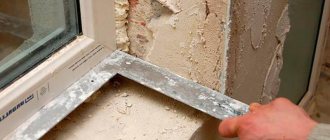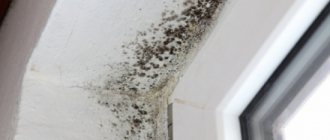Painting PVC profiles for plastic windows
The surface of the PVC profile or plastic windows to be painted must be clean and dry, and there must be no glue or silicone residues on it.
Immediately before painting PVC, it is necessary to clean the profile from dust and residual plastic chips and shavings with compressed air, remove the protective film, and protect parts of the profile that are not to be painted with adhesive masking tape. Using a rag soaked in a special cleaner for PVC, degrease and clean the PVC profile from dirt and glue residues, which also removes static tension. Before you start painting PVC windows with water-based paint for PVC, you need to wait for the time (1–2 minutes) necessary for the cleaner to evaporate from the surface of the profile.
At least one hour before the start of painting plastic windows, the paint is tinted to the required shade. Check the viscosity using a VZ-6 viscometer and, if necessary, adjust it by adding purified water - recommended values: 25-30 seconds. Before use, the paint should be filtered (filter 100-200 microns).
Reasons for repainting windows
Windows made of polyvinyl chloride profiles are rarely touched upon during cosmetic renovations of buildings. But in some cases it is necessary to paint them too. This happens in the following situations:
- the coating turned gray;
- the plastic has turned yellow;
- scratches and other defects have appeared that cannot be washed off or cleaned out;
- the interior changes, and the snow-white color of the frames becomes inappropriate;
- I had a desire to make my windows original, not like everyone else’s.
Manufacturers of PVC windows do not prohibit painting their products. Professional painting of plastic windows in various colors is often done using the lamination method - when a special laminating film is applied to the plastic. This can only be done by specialists with professional equipment. After this treatment, the windows receive, in addition to the new color, additional protection from ultraviolet radiation, high and low temperatures, aggressive chemicals, and precipitation. Another technology for processing window frames is spraying a layer of polyurethane enamel. Recently, window manufacturers, at the request of the client, paint polyvinyl chloride not in white, but with brown wood-like paint. But even the structure of this PVC is different. If the windows are already standing, then you will have to paint them yourself. In this case, you can get any color. This is interesting: painting wooden windows.
Yellowed plastic is one of the reasons for painting
Advantages and disadvantages
The films produced by acrylic varnish are easy to clean; any detergents other than solvents can be used on them. Acrylic varnishes show high wear resistance; no defects form on them over time. An important plus is that this material is harmless to people. On a smooth PVC surface, one coat is enough for most paints; double coating is required only when applying compositions with a metallic effect, or in case of significant defects. This cost-effectiveness is one of the advantages of PVC painting.
Pay attention to: Paint for leather seats and car interior: selection and painting process
Primary requirements
The main requirement that such paint must meet is high adhesion. Unlike wood, plastic has a smooth, slippery surface and a very hard, dense structure that does not provide a high level of adhesion between materials.
Also, the coloring composition must have the following characteristics:
- water resistance;
- strength;
- resistance to mechanical stress;
- resistance to UV rays;
- color preservation throughout the entire service life;
- the absence of toxic and poisonous substances that can be released when heated;
- resistance to temperature changes;
- long service life;
- wide range of colors;
- the ability to give an object a certain texture.
The ease of application of the composition also plays an important role, since plastic windows are often painted with your own hands.
Drying plastic windows after painting
With a wet film thickness of 80–120 microns, an air temperature of 23 ° C and a relative air humidity of 65%, the drying time from dust is no more than 1 hour, before storage 8 hours, complete polymerization of the paint coating after 7 days.
The drying time for metallic varnish before applying the film is 10 hours. With a large thickness of the wet layer, lower temperature and high humidity, the drying time can increase significantly - significantly!
A technology for accelerated drying of plastic windows at temperatures up to 50 °C is also possible. In this case, for the first 5–10 minutes the air temperature should be no higher than 25 °C, with a relative air humidity of 50–70%.
Polyurethane-acrylic paints
These dyes fully comply with all the necessary characteristics, these compositions are made on a water basis, they are often used to paint PVC, for example, plastic windows or other structures. Polyurethane-acrylic mixtures create a uniform coating that is resistant to scratches and other defects. The dye dries quickly enough on the PVC surface; if desired, you can tint the composition yourself. Thanks to these dyes, you can easily and quickly paint PVC, and it is possible to create any textured effects if you add special ingredients to the base paint.
Polyurethane-acrylic paints are made in a huge range of colors; the catalog contains more than two thousand different shades. In addition to traditional colors, manufacturers offer:
- pearlescent paints;
- with sparkles;
- metallic
Subtleties when painting surfaces
Choosing paint for PVC
It is better to paint plastic in one layer at room temperature. Pre-application of primers is not required here.
If you have the opportunity to use a spray bottle for work, this way the coating will be done better. Also, paints and varnishes can be applied using brushes or a roller.
Materials for painting take about 8-10 hours to dry, it all depends on the temperature. But, you can use painted plastic only after 3 days. If you need, the coating can be repeated, but only after the first layer has completely dried.
It is also worth paying attention to the fact that in any room there are many objects that can cause a fire or be damaged in a fire. To avoid this situation, it is better to buy fire-retardant paint for painting, the thinner of which is ordinary water.
Preparing the surface for painting
We paint PVC with our own hands
Painting a plastic profile with water-based acrylic paints has certain advantages, including:
- preparatory work is carried out quickly;
- the surface dries quickly at room temperatures;
- within 8-10 hours the finish gains strength at a temperature of only 20o;
- painting can be done either manually or with automatic sprayers;
- the paint has great decorative features (imitation wood, mother-of-pearl, metallic, etc.).
An important point before applying paint to a product is its preliminary preparation.
First of all, you must be sure that there is no dirt, silicone or polyurethane foam residues, greasy marks or other debris on the surface that will prevent strong adhesion of the plastic to the paints.
To properly prepare the surface, you can follow the following instructions:
- using a cloth or compressed air, remove crumbs and debris from the surface of the product;
- soak with specialized cleaning agents that are made specifically for polystyrene;
- remove grease and other lubricant mixtures from the surface, thereby removing static tension;
- Allow the surface 10-15 minutes for the cleaner to evaporate.
Following the advice of experts, it is better to purchase a specialized cleaner-activator for PVC, which, when applied, forms micropores on the surface that improve the adhesion of materials to each other.
Another known method for increasing adhesion is sanding the plastic and then priming it. But, this process is much more complicated and requires certain skills and experience from the master.
Related article: How to paint lining on a balcony: choosing varnish, impregnation, paint
Dyeing process
First of all, you need to prepare the tools and everything you need. PVC windows are painted using a regular paint brush or a construction gun. Equipment for painting PVC profiles can be purchased at a hardware store. If a gun has been selected for painting, it must be clean and dry.
Water-based paint is applied to the profile in one layer. If you want to get a metallic color, you will need two layers. When painting plastic windows, you can use different spraying technologies. Updating the appearance of plastic windows by painting gives the profile some protection and a qualitatively new look. Once window structures are painted, they are much easier to maintain.
Types of profile painting
After mixing special additives and stabilizers into the PVC composition, polyvinyl chloride changes its grayish tint to snow-white. This is the base color of the plastic profile. Depending on the further technological cycle, it may remain unchanged or change completely during the production process. Today, several methods for coloring profiles are actively used:
- coextrusion method;
- spraying method;
- mass coloring.
In addition, manufacturers offer a service for applying varnish to the surface of polyvinyl chloride products. Thanks to this treatment, the profiles acquire a noble matte shade and become velvety to the touch. The varnished coating is cured at high temperatures in special ovens, so it has a sufficient margin of safety.
When purchasing any painted windows for installation on the sunny side, you need to be extremely careful. It is necessary to ensure the quality of PVC, which should withstand operation at elevated temperatures. This is due to the fact that with prolonged exposure to sunlight, frames and sashes can become deformed if the quality of the polyvinyl chloride is not high enough. In addition, in such cases it is recommended to choose lighter shades.
PVC paint
If it is necessary to change the color of a finished profile, it can be painted. This process is not so complicated, but requires the use of special paints for polyvinyl chloride. For this, acrylic urethane or acrylic paint is usually used. Due to the specific surface structure of the material, special measures must be taken when painting. Before starting, you need to carefully prepare the surface to be painted. It is necessary to clean it from dirt and dust using water and a surfactant, preferably with a special product for products made of polyvinyl chloride or a solution of isopropyl alcohol. Before applying a layer of paint, it is also necessary to treat the surface with a solvent-activator, which makes it possible to give the PVC greater adhesion to acrylic paint. After such preparation, the product can be painted.
Aerosol paints
Acrylic spray paint for PVC is especially suitable for painting plastic products. The container protects the paint from air penetration and the formation of a film on the surface. On the labels of such paints you can find the words: “Plastic” or “Multi-Surface”.
Advantages
- high level of adhesion;
- ideal for painting small parts and hard-to-reach places;
- does not require additional tools;
- creates an even and smooth coating;
- dries quickly;
- economical to use.
Flaws
- If cleaning is not done in a timely manner, the nozzle may dry out;
- spray painting requires certain skills.
Coloring plastic at home
You can handle painting plastic materials yourself; this will greatly save your budget. Turning to professionals is very expensive. To carry out the work at home yourself, you will need to take care of your own safety by preparing protective equipment, also prepare all the necessary tools (listed above), and perform all stages of the work. They will be discussed in detail further.
Painting methods
The paint coating is available either in cans or in aerosols. Which option to choose depends on the size of the product and the experience of the person who will carry out the painting work.
- Spray cans are more appropriate for a small painting object; they are not difficult to work with, but before you start, you should try it out by spraying a little paint on an unnecessary surface, this will help you understand how best to spray to get the desired result. In general, the aerosol method will give a good, even coating. This method does not allow you to mix tones, and thus it will not be possible to apply clear color boundaries.
